Between Bites in San Sebastián
A guide on what to do when you aren't eating in Spain's food capital
Playa de La Concha. This is our first stop in San Sebastián.
When traveling, there’s always a First Stop. It’s not really the first place on the itinerary, or even the first place I go to. It’s the first place when I pause. I take a breath. I realize where I am and just how astounding it is. It’s the first stop when I’m not calculating distances and times and consulting Google Maps.
We’re on a 40-minute walk from the bus station to Barrio Antiguo, where we will check into our hostel. But it’s passing Playa de La Concha when we decide to stop. We find ourselves seated at Café de La Concha, a quaint seaside cafe with intricately swirling architecture, wrought iron, and a red neon sign that sparkles over its entrance.
A gray sunset with a stripe of pink at the horizon. Blue, chilly looking water. It’s calm and it laps itself up to the shore with a swaying rhythm. Relaxing ocean waves. It starts to drizzle out. A pitter patter of raindrops into my wine glass. Watered down. Still dry. A slight bubble to it. Txakoli wine. This must be how the locals drink it, with a bit of rainwater mixed in.
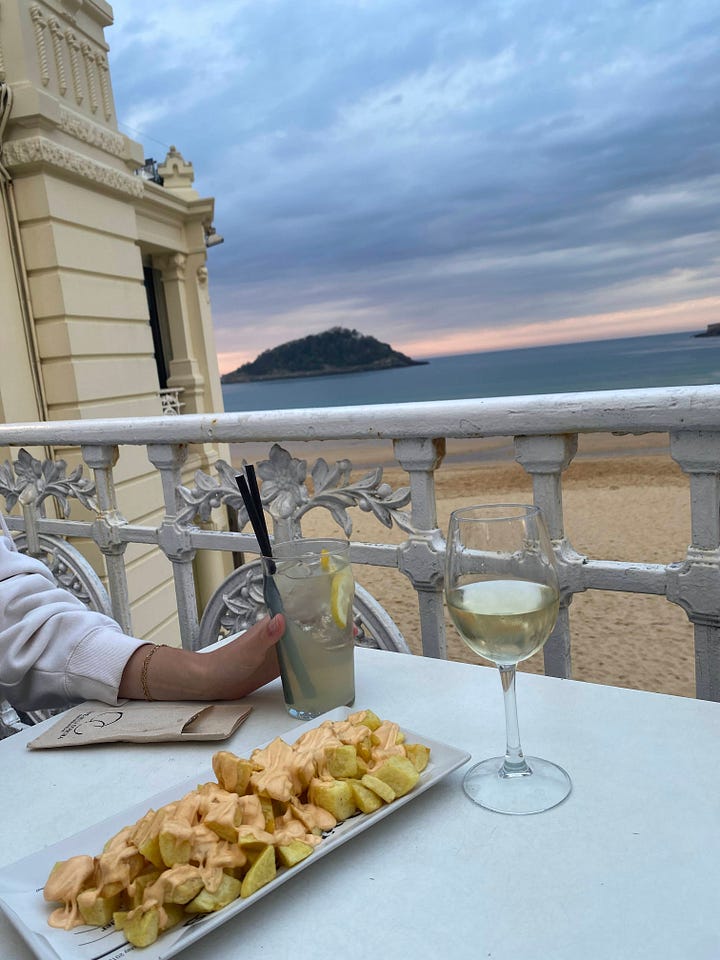
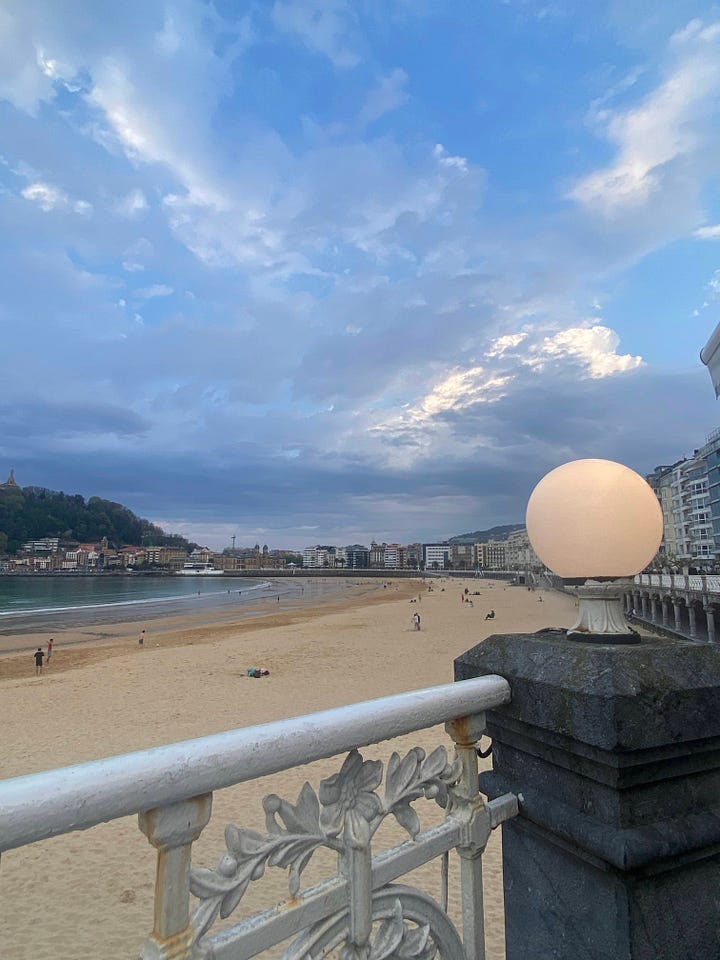
When we’re not sipping on a drink or trying a pintxo in San Sebastián, we’re climbing up stairs. Excited and curious, but sticky with sweat and humidity from leftover rain. I’m a bit more focused when going up the stairs, since they can be steep and uneven and can tire me out. My eyes flicker between looking at Google Maps and keeping an eye on the seemingly never-ending mossy, concrete stairs. Going downhill, of course, the world is my oyster. Sometimes we become too confident, too carefree, as we continue down a set of stairs. And another. And another. Someone’s quaint little hillside townhouse catches our eye. Look at their potted plants ohhh! And the view from their garden, wow!
And then I find myself looking at an alleyway that seems to connect this set of townhouses to a different road. And I start to ponder what it would be like to live here. How would I get my groceries from a townhouse like these? Oh look, some stairs. Yes, I would probably use the stairs that are situated perfectly between my set of townhouses and the row next door.
And so stairs turn into more stairs. Turn into alleyways. Turn into invasively peering into someone’s balcony or garden. Turn into more alleyways and more stairs.
Eventually we will realize that we’ve overshot the destination, now three quarters of the way down a hill when the cafe recommended to us is somewhere more like halfway down.
Back up we go.
This is the ebb and flow of walking around San Sebastián .
And because we’ve been walking so much, of course we need to eat again.
Eating in San Sebastián
San Sebastián has the most Michelin star restaurants per capita of any city in the world. This means you will, as we did, find yourself eating life-changing meals and snacks at an unassuming spot. Then, you’ll pay the bill and leave, noticing a Michelin-star sticker in their window or a wooden-framed prize claiming their top premio for pulpo a la gallega or whatever dish they make best.
But if stumbling into Michelin star restaurants isn’t your style, you can go Michelin star hunting as well. We did this when we went to Bar Nestor, located by Plaza de la Constitución. This plaza and the surrounding area are full of amazing tabernas and cafes to try out.
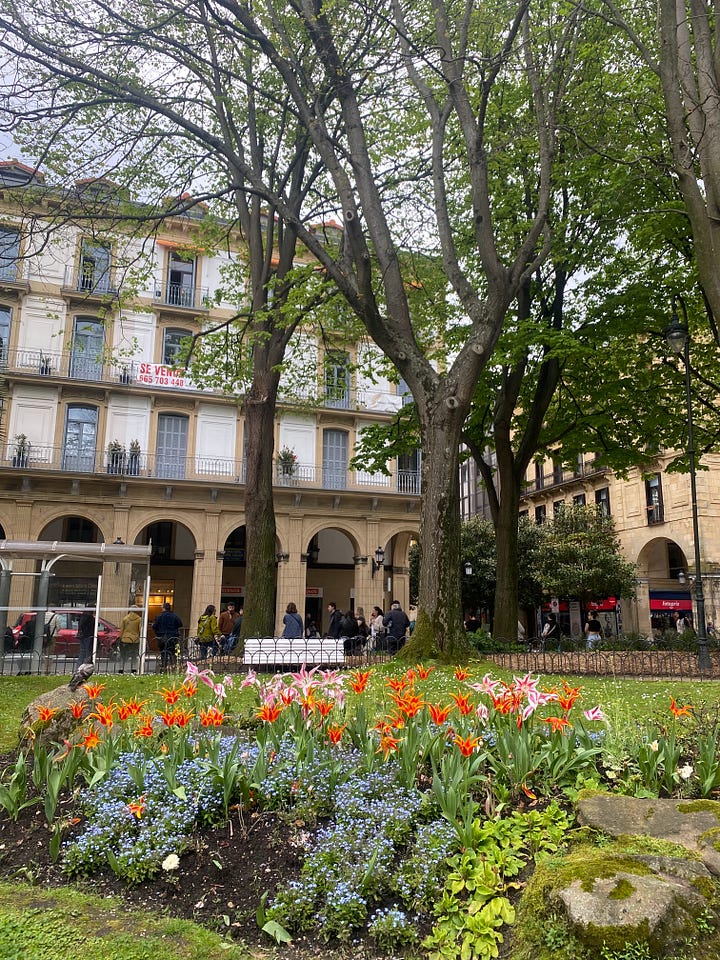
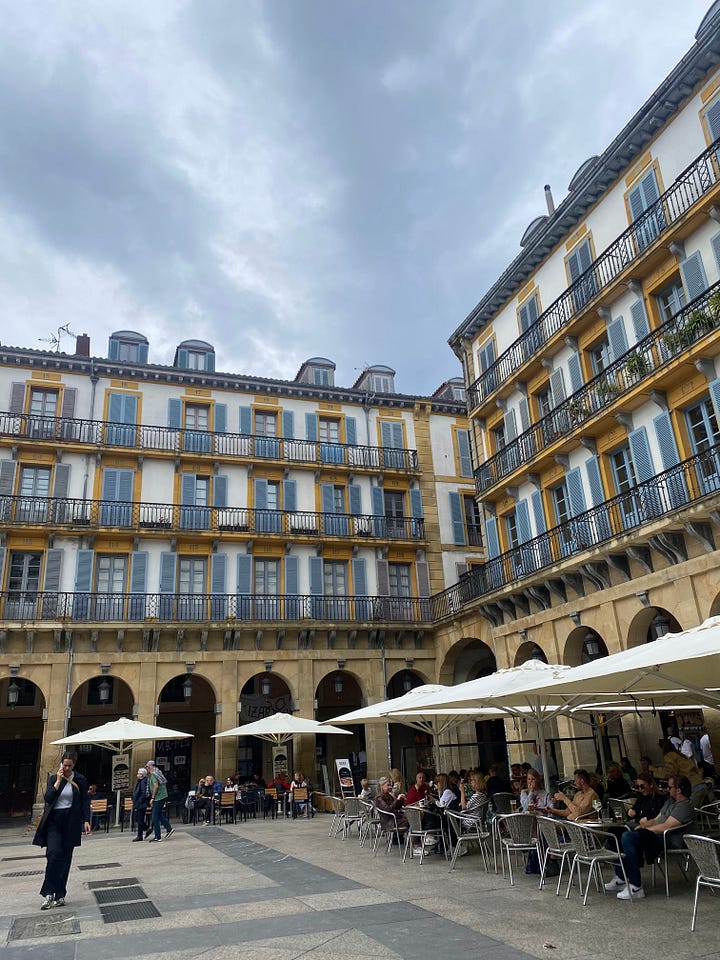
Bar Nestor is an old school spot. It’s a narrow space, mostly standing room. We’re shoulder to shoulder with other patrons. The workers behind the bar are yelling to us, calling us chicas, to “seat” us at the bar— rearranging the patrons already eating there to accommodate more clientele. It smells like smoke and olive oil. We order kalimotxos— a brilliant Spanish invention of the region. A kalimotxo — equal parts red wine and cola — is the perfect mid-afternoon drink for when you can’t decide between wine or something with caffeine to pick you up from your afternoon slump.
At Bar Nestor we order pimientos de padrón and a tomato dish that we see nearly everyone eating. The peppers are steaming when they come out, perfectly grilled with chunky sea salt flakes. The tomatoes are simply the freshest, most flavorful I’ve ever had in my life (I’m not exaggerating). They’re dressed simply: olive oil and more sea salt. They’re tangy and sweet and have a crunchy texture. I mop the plate of olive oil and tomato juice up with bread and wash everything down with my kalimotxo.
Other food highlights include…
La Tahona: A quaint, old-school bakery with delicious pastries like croissant a la plancha, trenzas, and torrijas.
Kalaberri Taberna: A very typical pintxos spot, where the man working the bar might forget your order because he’s busy watching the soccer game on the TV in the corner.
Somos Bakery: A modern brunch spot with dishes like American pancakes, Shakshuka, avocado toast. I had a really delicious chai latte here served in a hand-thrown clay mug.
Arenales Wine Bar: A tiny wine bar with dim lighting, offering an array of natural wines. Sit and get cozy in this little spot as you wait out the San Sebastián rain.
Monte Igueldo and the Funicular
San Sebastián is famous for its food and its steps. But if you’re getting tired of all the uphill walking and want a different view of the city, Monte Igueldo might be just the spot.
When we arrive at the funicular, it’s an unassuming stone building with evergreen shutters and wooden details. Though a common tourist sight to see, there’s hardly any cars in the parking lot, and we’re one of very few pedestrians. The inside of the station is dark. It has yellow walls with chipping paint and those ropes with retractable belts for crowd control. A winding maze is made from these ropes, controlling a crowd that isn’t here today. I’m half surprised when I see a woman working here. She’s sitting low in her seat in a window at the end of the line, so her head is just barely visible. We buy two tickets from her.
Although the station seems abandoned, we manage to pick the one cart of the funicular with other people already in it. It’s a young American couple, probably my age or a bit younger. There’s tension – something about the funicular taking forever and concerns it will be boring. I get it. It’s a ramshackle station, with sleepy workers loading you onto a rickety old thing that you trust to take you almost 90 degrees straight up a steep mountain. You’ve spent a lot of money on your flight to Europe, you only have a few days of vacation, and she wants her Instagramy pictures and a cocktail in hand.
They’re debating back and forth about if this sight is worth it, what they’ll do next, if they’ll have time to lay out on the beach today, oh and she wants to do some shopping too, blah blah blah… This is the soundtrack to which we make our ascent.
It reminds me a bit of an old wooden roller coaster, without any of the speed. It creaks and sways a bit. The windows are open, inviting the cool, fresh breeze to pass through the musty funicular car. It smells like grass and wildflowers and minerals and the sea. The tree branches outside the windows are just about to touch us. It’s so lush here, it’s surprising the trees and the vines and the grass haven't overtaken the funicular tracks by now. I wonder if they have to run the funicular a minimum amount of times per day, regardless of if there are passengers, just to keep the thing running and maintained.
We reach Monte Igueldo. The quaint city of San Sebastián with narrow alleyways and stairs and vines and overgrowth suddenly opens up. We’re overlooking Playa de la Concha, where the Atlantic Ocean is calmed by the natural landscape of rocky cliffs and protected coastlines.
It’s quiet up here. There’s hardly anyone. The famous amusement park that has put this mountain on the map since 1912 is closed today. It’s unclear if it’s closed for the season, or for maintenance, or if it’s just closed for the day. I consider if it could be abandoned completely. There’s something kind of adventurous, if not spooky, about exploring the ramshackle amusement park with boarded up entrances for attractions like Montaña Suiza (Swiss Mountain), Gran Laberinto (Grand Labyrinth), and Casa del Terror (House of Terror).
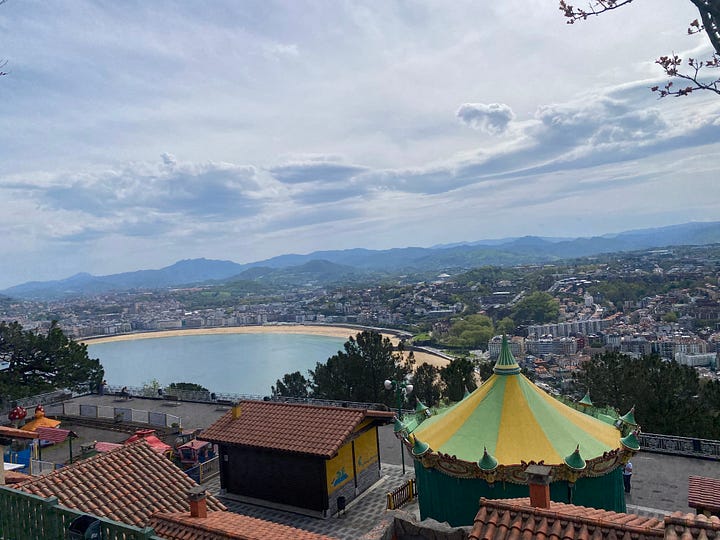
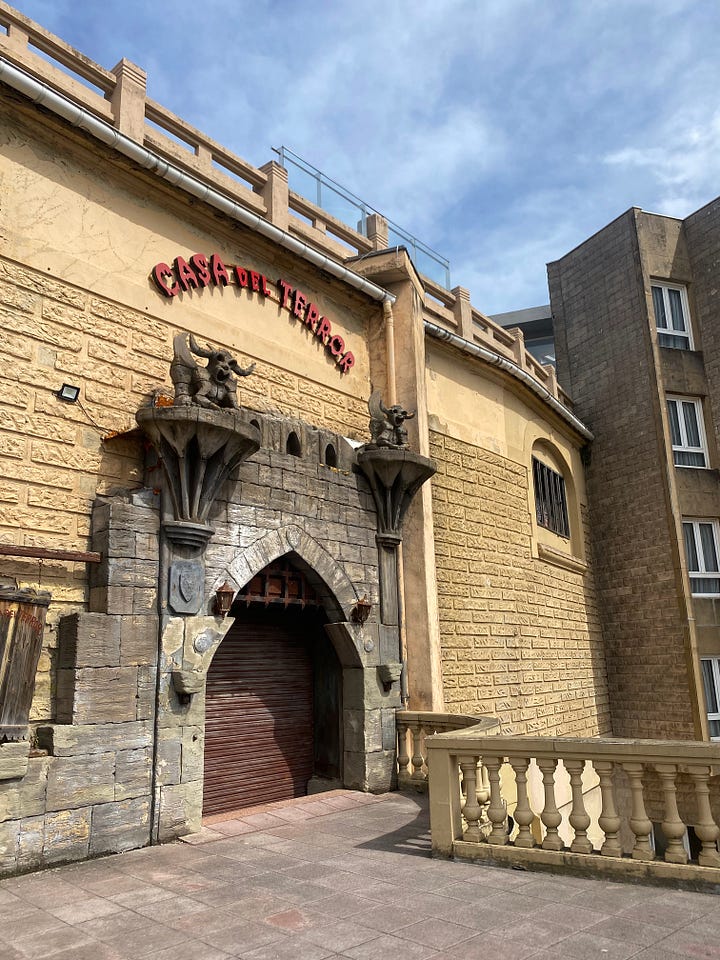
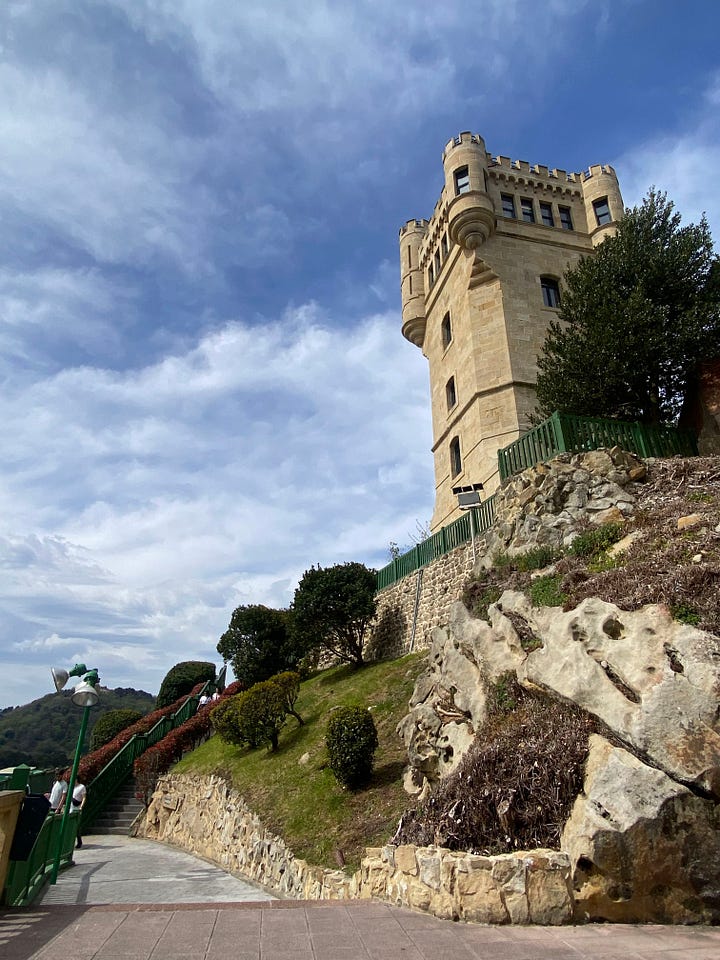
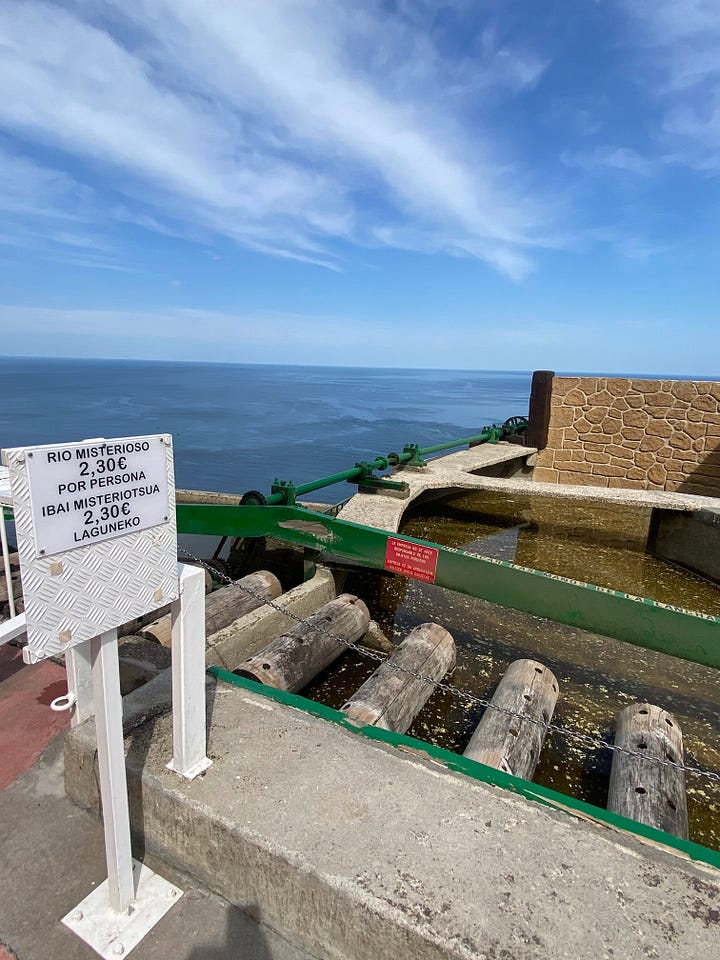
Empty rollercoaster tracks wind around the summit of Monte Igueldo. Water rides that aren’t running accumulate moss and algae. A rollercoaster cart with fading paint sits peacefully. Birds fly overhead. I take a seat on a wooden bench. I imagine it’s one used by parents as they watch their kids yell in excitement and swoosh by on a rollercoaster. And as I look out, the calm blue of the ocean engulfs me. A cool breeze grazes my skin. I think about where I am, that if we went further in this ocean we would hit the UK. Or the US, if you made a turn. That somehow this beautiful blue water is the same concrete gray ocean of childhood memories at the Jersey Shore.
And as I ponder this huge ocean, the one I have known all my life, I start to picture the ramshackle amusement park rides as the beloved rides of my own childhood. Jenkinson’s Pier in Point Pleasant, New Jersey. The Super Himalaya and the Tilt-A-Whirl. Are those rides still there? Are they as vibrant and fast and exciting as my memories? Or might they match Montaña Suiza here— sun bleached and dusty?
I start to feel slightly nostalgic for the rides at Monte Igueldo, although it’s my first time here. Beyond faded paint and chipping wood and algae growths— underneath all of this, there is something familiar.
San Sebastián at Night
The damp, somewhat sleepy seaside city of San Sebastián comes alive at night. As we wind our way through small alleyways, suddenly the Basílica de Nuestra Señora del Coro appears between buildings. As we get closer, the bar doors open up and we find people all over the street, a glass of wine or a bottle of beer in hand. Some lean against the walls of the buildings, many sit on the steps of the basilica. They sip their drinks— laughing, chatting, maybe waiting for a table to open up at one of the many restaurants and tabernas around. The air is crisp and fresh, with occasional whiffs of cigarette smoke.
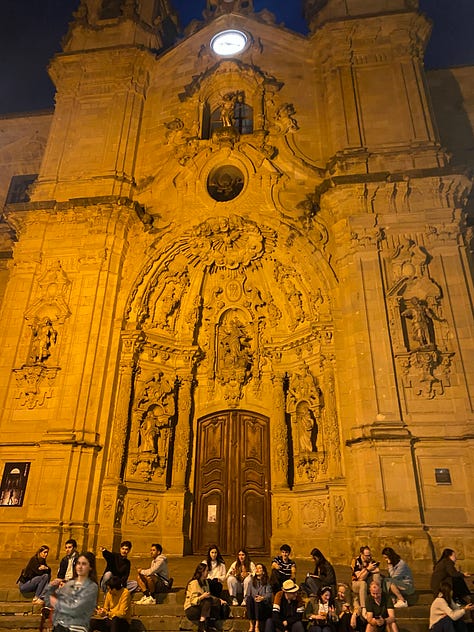
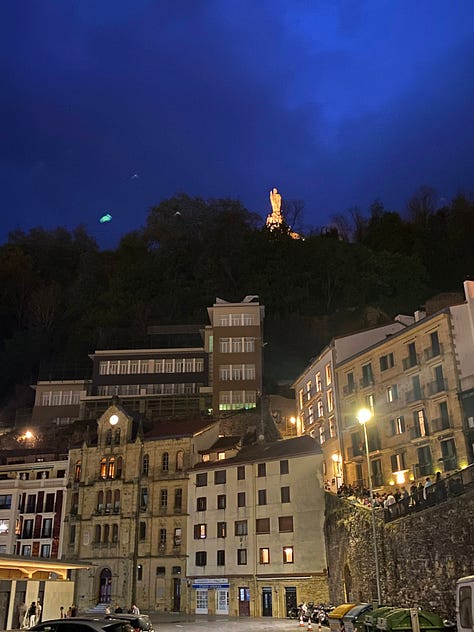
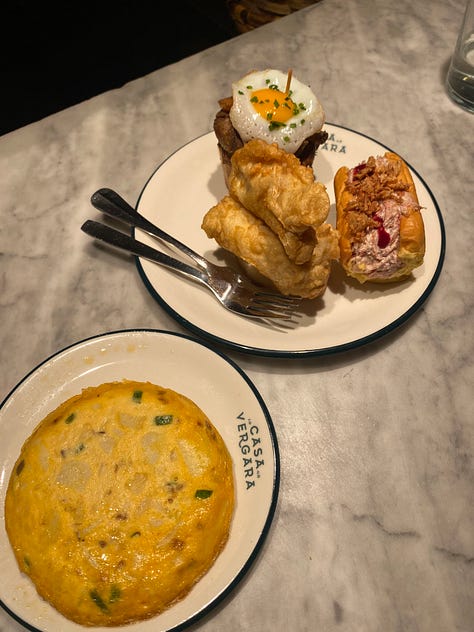
We grab a table at Casa Vergara, a stylish and somewhat swanky take on the usual wooden-bar-stooled, sticky-floored tabernas we’ve been going to so far. There, we enjoy an array of items. At first, just some divinely crisp croquetas and a glass of wine. Then tortilla de patatas with a green onion/leek twist. Oh and did you see what they’re having over there? Let’s get one of those. A beef and portabella mushroom pintxo with a quail egg on top. Some kind of seafood salad on a mini brioche bun. Should we get another glass? Otra copa de Txakoli, porfa.
And so we spend our last night in San Sebastián enjoying the lull and tempo which has characterized the our entire trip here. Poco a poco, little by little. Walk a bit, stop, disfruta. A little bit of rain, and then it’s over. Bright sunshine that threatens to burn your skin, and then a cloud.
Pintxo after pintxo. Step after step. Stairs after stairs. Bar after bar. Find things to do while you digest. And then go again.









